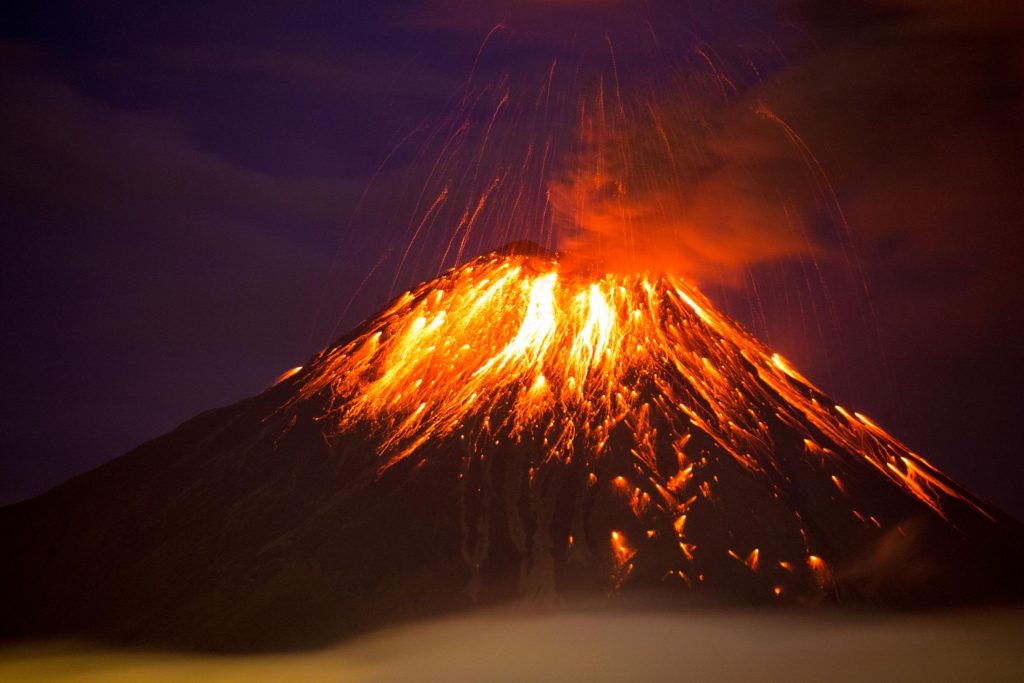
Have you ever wondered why volcanoes burst open and pour out fiery lava? Or how those giant mountains suddenly roar and send ash into the sky? Today, we’re going to explore why volcanoes erupt, in a way that’s fun, easy, and perfect for curious young minds.
What Is a Volcano, Anyway?
Let’s start with the basics. A volcano is like a giant mountain with a hidden secret; it’s hollow inside! Deep beneath our feet, under Earth’s crust, is a layer called the mantle. It’s super hot there. Melted rock called magma collects in a pocket called a magma chamber. Imagine a balloon filling with fiery rock instead of air.
Now, the volcano sits above that chamber, with vents or cracks called fissures. These are escape routes for the magma. So, a volcano isn’t just a mountain; it’s Earth’s pressure cooker. And eventually, that pressure needs to go somewhere. That’s why volcanoes erupt.
Pressure Builds Beneath the Surface
Think of a shaken soda bottle. When you pop it open, everything explodes out. That’s because trapped gases in the soda expand quickly once released. In the ground, gases like water vapor and carbon dioxide are dissolved in the magma. As magma rises, the pressure drops and those gases want out, fast.
Over time, more magma pushes up. The gases get trapped because the crust above is strong. But magma keeps rising, squeezing the chamber tighter and tighter. Eventually, the pressure becomes too much. BOOM, the volcano erupts. Hot lava and volcanic gases shoot out in a spectacular, sometimes scary, natural display.
Different Kinds of Eruptions
Did you know that not all volcanoes erupt the same way? Two key things change how violent an eruption is: magma thickness and gas content.
- Thin, runny magma (like in Hawaii) lets gases escape slowly. That makes gentle lava flows that hardly hurt anyone.
- Thick, sticky magma (like at Mount St. Helens) traps gases until they explode all at once. That’s when ash clouds and fast lava blasts shoot into the sky, and that can be dangerous.
The U.S. Geological Survey explains this literal pressure cooker scenario perfectly: when magma is thick, it holds in gases like a sealed bottle, and when it blows, it’s explosive.
Where Do Volcanoes Form?
Volcanoes often pop up in places where tectonic plates meet, those giant puzzle pieces making up Earth’s surface. One interesting place is the Pacific Ring of Fire, a horseshoe pattern of volcanoes circling the Pacific Ocean. That’s where Mount St. Helens, Mt. Fuji, and many others live.
But volcanoes can form elsewhere, too. When plates move apart under the ocean, magma rises and creates islands like Iceland. Or, big hot spots beneath stable crust, like Hawaii, can build volcanoes right in the middle of a plate.
What Happens During an Eruption?
When a volcano erupts, here’s what usually happens:
- Magma burst — liquid rock shoots up and may flow gently or blow violently.
- Ash and rock spew — chunks become ash and scatter.
- Gases dump — poisonous things like sulfur dioxide may drift into the sky.
- Lava cools — once on the ground, lava turns into solid rock.
These eruptions can be powerful. For example, Mount St. Helens in 1980 blew off 1,300 feet from its top! It also released tons of ash that travelled hundreds of miles, crazy powerful stuff.
Volcanoes Can Help Too!
Volcanoes aren’t all destructive; they do good things as well. When they erupt, they spread nutrient-packed ash that turns into some of the most fertile soil on Earth. That’s one reason people often farm on volcano slopes despite the risks.
Also, underground heat from volcanoes provides geothermal energy, clean and renewable. Places like Iceland get up to 25% of their electricity just from geothermal power!
Amazing Volcano Facts (for Kids)
- The world’s largest active volcano is Mauna Loa in Hawaii, standing 4,169 meters tall.
- Over 1,500 active volcanoes are known in the world today.
- The 1883 Krakatoa eruption was so powerful it was heard over 3,000 miles away!
Volcanoes are Earth’s big drama queen, and we’re constantly learning from them.
Can We Predict Eruptions?
Scientists keep a close watch on volcanoes, especially active ones. They watch for:
- Earthquakes near volcanoes
- Ground shifting or swelling
- Changes in volcanic gases
- Tiny landslides on the volcano slopes
By studying patterns, like they did before Mount Pinatubo erupted in 1991, scientists can often give a warning days or even weeks before a major eruption.
Still, predicting the exact moment is very tough. Volcanoes are tricky, and sometimes they surprise us.
Why Volcanoes Matter to You
Volcanoes teach us about Earth’s fiery heart. They show how our planet’s inside, deep under layers, affects what happens on the surface. They remind us how strong and unpredictable nature can be.
For kids, learning about volcanoes is an exciting peek into Earth science. Plus, the next time your teacher says “magma chamber” or “tectonic plates,” you’ll understand the story behind the words, and maybe even wow your friends with fun facts!
Final Words: Lava Up Your Curiosity
So, why do volcanoes erupt? It comes down to a mix of pressure, trapped gases, heat, and shifting plates. When Earth’s deep energy finds a way out, we get that fiery, sometimes scary, but always fascinating eruption.
Volcanoes are powerful reminders that our planet is alive, stirring, and full of surprises. Whether you’re peeking up at steam clouds or tracking tremors, volcanoes show us one simple truth: Earth has more stories to tell, and they’re lava-ly exciting!


Leave a Reply